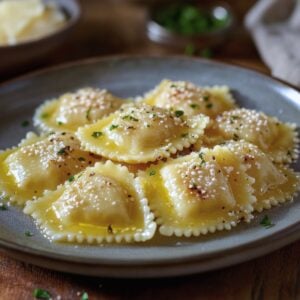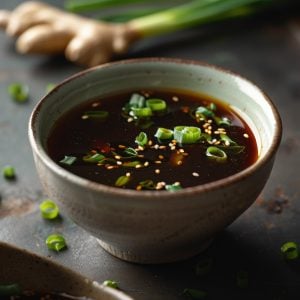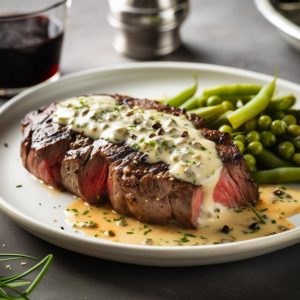A Classic French Brown Sauce From Bordeaux
Bordelaise sauce, a classic of French cuisine, is a rich and flavorful sauce named after the Bordeaux region, renowned for its wine. This elegant sauce is traditionally served with grilled meats, especially beef, enhancing the dish’s deep, complex flavors. The preparation of bordelaise sauce is rooted in French culinary techniques, emphasizing the use of high-quality ingredients and precise cooking methods.
The core ingredients of bordelaise sauce include red wine, typically from Bordeaux, demi-glace, shallots, bone marrow, butter, and herbs such as thyme and bay leaf. The use of Bordeaux wine is essential, as it imparts the characteristic depth and richness to the sauce. The demi-glace, a concentrated brown sauce made from veal or beef stock, provides a velvety texture and robust flavor. Shallots contribute a subtle sweetness and mild onion flavor, while bone marrow adds richness and a luxurious mouthfeel.
Making bordelaise sauce begins with reducing the red wine, which intensifies its flavor and helps concentrate the sauce. Shallots are finely chopped and sautéed until translucent, then combined with the wine reduction. The mixture is simmered with thyme and a bay leaf, infusing the sauce with herbal notes. Once the wine has reduced significantly, the demi-glace is added, and the sauce is simmered until it reaches the desired consistency. The final step involves whisking in butter and bone marrow, which enrich the sauce and give it a glossy finish.
Bordelaise sauce is renowned for its versatility and ability to elevate various dishes. It pairs exceptionally well with grilled or roasted meats, such as filet mignon, ribeye, or beef tenderloin. The sauce’s rich flavors complement the natural taste of the meat, creating a harmonious balance. Additionally, bordelaise can be served with other proteins like lamb or duck, and it even enhances vegetable dishes, providing a gourmet touch.
Beyond its culinary applications, bordelaise sauce represents the essence of French gastronomy. Its meticulous preparation and reliance on quality ingredients reflect the French dedication to culinary excellence. The sauce’s origins in the Bordeaux region also highlight the importance of regional specialties and the integration of local products into traditional recipes.
Bordelaise sauce is a testament to the sophistication and depth of French cuisine. Its harmonious blend of red wine, demi-glace, shallots, bone marrow, and herbs creates a luxurious and versatile sauce. Whether accompanying a succulent steak or enriching a vegetable dish, bordelaise sauce exemplifies the art of French cooking, turning ordinary meals into extraordinary culinary experiences.
History of Bordelaise Sauce
Bordelaise sauce, a culinary jewel of French cuisine, has a rich history that reflects the culinary traditions and agricultural bounty of the Bordeaux region. The origins of this sauce are intertwined with the history of Bordeaux, a region famed for its wine production and gastronomic heritage.
The Bordeaux region, located in southwestern France, has been renowned for its vineyards and high-quality wines for centuries. Bordeaux wines, particularly red wines made from grape varieties like Cabernet Sauvignon, Merlot, and Cabernet Franc, have long been celebrated for their depth and complexity. These wines became a central ingredient in the development of Bordelaise sauce, as their robust flavors complement the richness of meat dishes.
The creation of Bordelaise sauce can be traced back to the 19th century, a period when French cuisine was becoming more codified and refined. During this time, chefs in Bordeaux began to experiment with using the region’s abundant wine to create sauces that would enhance the flavor of meats. The term “Bordelaise” itself simply means “from Bordeaux,” indicating the sauce’s geographic and cultural origins.
Bordelaise sauce is traditionally made with red wine from Bordeaux, demi-glace (a rich brown sauce made from veal or beef stock), shallots, and marrow bones, along with herbs such as thyme and bay leaf. The inclusion of bone marrow is a hallmark of classic French cuisine, adding a luxurious texture and depth to the sauce. The use of demi-glace, a labor-intensive and deeply flavorful reduction of stock, is another indication of the sauce’s roots in high-end French culinary techniques.
The sauce’s evolution is closely tied to the development of French haute cuisine in the 19th and early 20th centuries, particularly the influence of renowned chefs like Auguste Escoffier, who helped to codify French culinary techniques and recipes. Escoffier’s work in organizing and standardizing recipes brought Bordelaise sauce into the repertoire of classic French sauces, ensuring its place in culinary history.
Bordelaise sauce was popularized in French restaurants and became a staple in fine dining establishments. Its association with high-quality Bordeaux wines and the precise techniques required for its preparation made it a symbol of French gastronomic sophistication. Over time, the sauce spread beyond France, becoming a beloved component of international cuisine, particularly in restaurants that focus on classic French dishes.
In modern times, Bordelaise sauce continues to be celebrated for its rich, complex flavors and its ability to elevate a variety of dishes, particularly grilled or roasted meats. It remains a testament to the culinary heritage of the Bordeaux region and the enduring influence of French culinary traditions on global cuisine.
Bordelaise Sauce Recipe
Ingredients
- 1 ounce butter 1/4 stick
- ¼ cup finely chopped shallots
- ½ cup Bordeaux red wine Substitute any claret style red wine
- 1 sprig fresh thyme
- ¼ teaspoon cracked black peppercorn
- 1 cup demi glace
- 4 ounces diced beef bone marrow
Instructions
- Prep the ingredients by removing the thyme leaves from the stems. Save the leaves and discard the stems. Crack the black peppercorns.
- To prep, the bone marrow, dice it and simmer it in a small pot of water for 3 to 4 minutes. Then, drain the diced marrow and reserve.
- Heat a saucepan over medium heat. When hot, add the butter, melt, and then the shallots.
- Sauté the shallots for a couple of minutes until they become translucent but be careful not to let them burn.
- Remove the pan from the heat source, add the red wine, return the pan to the heat and reduce for 2 to 3 minutes. Finally, add the fresh thyme & cracked peppercorns.
- Continue reducing the liquids until most of the wine is cooked off.
- All the cookbooks say, “cook to an essence,” and to me, that means to cook until there is very little liquid left in the pan.
- Add the demi place to the pan and simmer for approximately 6 minutes until the sauce begins to thicken. Be sure to stir every so often so the sauce does not burn.
- Add and stir the reserved bone marrow to the sauce and continue simmering until the marrow has melted and incorporated well into the sauce.
- Reduce the sauce until it is thick enough to coat the back of a spoon.
- This sauce is good on most cuts of grilled meats, including venison but is especially great on beef tenderloin or juicy sirloin steak.

















17 Responses
Hello, and thankyou for the recipe. I’m interested to see that you don’t use butter to emulsify the sauce at the end of cooking. What would the difference in the end result be with the two variations (ie with and without butter)?
Butter and marrow are both high fat substances that will emulsify the sauce. The difference will lie in the flavor each imparts. If you’ve never tried bone marrow, do. It’s delicious, and will intensify the beef flavor of the sauce.
hello, just thought i would make a few comments. this is a classical sauce. it was originated in the are of bordeux not because of the wine, so any red wine will work. all chefs eventually will change a recipe. however this is a classical sauce. certain things do not ever change. shallots, red wine, lemon juice, demi glace and bone marrow are a must. if not you are making something else. place butter at the end of any demiglace sauce is typical to round it out. heavy cream is not unless your wanting your sauce to look like stroganoff. check books like escoffiers sauce bible or the professional chef for classical sauces
I was trained to leave nice slices of marrow in the sauce. This provides an added texture and surprise goodie, but also proves that you used bone marrow.
Thanks for that tip Andy.
90% of the recipe is making the demi glacé and you just skimmed over that entire process by saying 1 cup…
Hi Johnathon, I need to link this recipe to https://www.reluctantgourmet.com/demi-glace-recipe/ so you can see how to make it at home.
Question on the marrow. Does it need to be pre roasted in the bone like when I spread it on toast, or can I put it into the sauce raw?
Hi Jason, if you have roasted bone marrow great, but if not the recipe directs you to “To prep the bone marrow, dice the bone marrow, and simmer in a small pot of water for 3 to 4 minutes. Drain the diced marrow and reserve.” Hope this helps.
This is the closest you’ll get to crediting a modern source. Escoffier didn’t come up with the brown mother sauce or the daughter bordelaise sauce, but he codified classic French cooking. When Julia Childs started writing cookbooks containing French recipes, she was giving us a more modern version of Escoffier. Have you compared a homemade demi-glace with a quality purchased one side by side? Wondering if you sacrifice a fair amount of taste by skipping the long process of creating it from scratch.
Hi David, thanks for reaching out. I can see why high end restaurants make their own demi glace from scratch because of the amount needed for their dishes and how often they include it with their recipes. As a home cook, I don’t use that much demi glace and now that I’m not eating as much red meat as before, I’m using even less. That’s were some of the commercial products come in. They have a great shelf life and I have them when I need them without the hours of work of preparing it from scratch. Is homemade better? I guess that depends on who’s preparing it, ingredients available and how much attention you give it when preparing it. If you make a mistake and it burns just a little, it’s not going to be very good. You really have to pay attention for a long time when making something like demi glace from scratch.
Where can I purchase bone marrow?
I have seen it in many specialty food stores and once in a while in my local supermarket. Not sure where you live but ask a local butcher to get you some. I’m sure they would be happy to.
Any recommendations to make this ahead of time? Also, do you have any recommendations/tips to increase the recipe to serve about 40 people?
Sure, you can make this ahead of time and refrigerate and reheat when you need it. Not sure how to increase it for 40 people unless I know how much you plan to use for each plate.
Is there any commercial/store bought demi glaze that you would recommend?
Thank you!
Great question Janine. Now that More Than Gourmet is no longer available for retail purchases, I’m looking for a suitable alternative. I just tried Savory Choice Beef Demi Glace and was underwhelmed. It was way too sweet for my liking. A grocery store near me sells the Bonewerks in 1-pound packages. I will give this a try asap and write about it on my website.